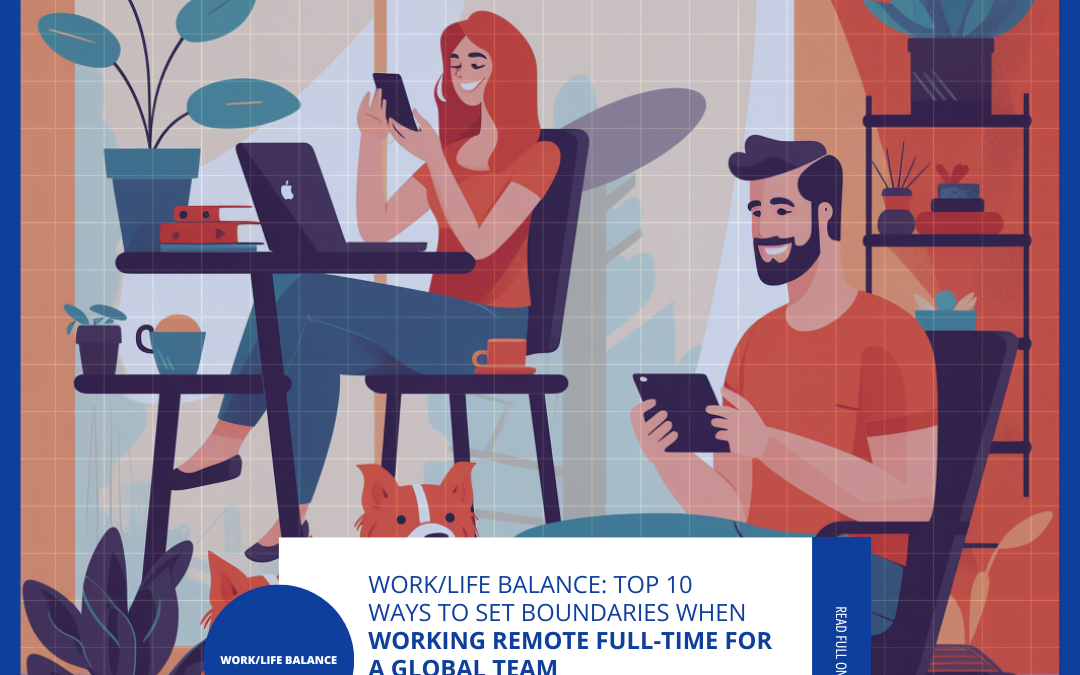The office is no longer a place you go; it’s an environment you create. In a world where the 9-to-5 grind has evolved into a dynamic, fully remote job with a global virtual team, the lines between work and life often blur. But fear not, for establishing work-life boundaries in this modern work landscape is not only possible but essential for your well-being and productivity.
We’re living in an era where the concept of “going to work” has been redefined. Remote work has rapidly evolved, driven by technological advancements and the realization that productivity isn’t confined to a cubicle. With virtual teams dispersed across time zones and continents, the way we approach work-life balance has changed, too. Below are the top 10 key strategies to help you master the art of work/life balance.
1. Design Your Workspace:
Creating a dedicated workspace at home is akin to carving out your territory on the global remote work map. It sends a signal to your brain that when you’re in this space, it’s time to work. Invest in a comfortable chair, a well-lit area, and organize it to mimic your office setup.
Design a workspace at home that signals when you’re in it, you’re at work. Equip it with everything you need for a productive work environment.
- Transform a spare room or a corner of your living space into a home office with a comfortable desk and chair.
- Set up a dedicated area with good lighting and noise-cancelling headphones to minimize distractions.
2. Define Your Working Hours:
In a global team, someone is always online. Stick to this schedule as closely as possible. Having a set time when you’re “at the office” and a time when you’re “off duty” helps maintain balance.
Set clear working hours and communicate them with your global virtual team to ensure that your personal time is respected, even across different time zones (ex. NAMER to EMEA, NAMER to APAC, etc.).
- Establish a daily schedule with fixed working hours that align with your team’s core hours for collaboration.
- Use calendar tools to block off personal time and avoid scheduling work-related activities during these periods.
3. Embrace Flexibility w/ Boundaries:
Flexibility is one of the perks of remote work. Embrace it, but set boundaries around it.
While remote work offers flexibility, balance it with clear boundaries. Tailor your work hours to your needs while aligning them with team meetings and deadlines.
- Start your workday later to accommodate personal needs, but remain available during core team working hours.
- Set boundaries by turning off work-related notifications during designated personal time.
4. Unplug & Disconnect:
Working from home doesn’t mean working 24/7. Create a shutdown routine to signal the end of your workday. Close your laptop, turn off notifications, and step away from your workspace. Disconnect from work-related devices and activities to reclaim your evenings for personal time.
- Close your laptop, turn off work-related notifications on your phone, and log out of work accounts at the end of the workday.
- Use this time to engage in personal hobbies, spend quality time with family, or simply relax and unwind.
5. Prioritize Self-Care:
Regular exercise, meditation, or simply taking breaks to go for a walk can do wonders for your work-life balance. Make self-care a part of your daily routine to maintain physical and mental well-being.
- Dedicate time for daily exercise, whether it’s a morning jog, yoga, or a home workout.
- Practice mindfulness through meditation or relaxation techniques to reduce stress and improve focus.
6. Set Communication Boundaries:
In a global virtual team, messages may flow at all hours. Establish clear boundaries for communication. Use collaboration tools to prioritize tasks and avoid late-night work chats.
7. Plan Your Days:
Create a daily schedule that allocates time for work, family, and personal pursuits. Make to-do lists, and stick to them. This structure can help you stay organized and maintain work-life equilibrium.
8. Communicate Expectations:
Be transparent with your team about your availability. If you need time off or a day to recharge, communicate it in advance. Encourage open dialogue within your team about each member’s boundaries. Establish clear communication boundaries within your global virtual team to prevent work-related interruptions outside of working hours.
- Use collaboration tools to prioritize tasks and indicate their urgency, reducing the likelihood of non-urgent messages during personal time.
- Encourage your team to respect each other’s downtime and refrain from sending non-essential messages during evenings and weekends.
9. Travel Mindfully:
Remote work allows flexibility, including the option to work from different locations. While travel can be enriching, it can also disrupt your routine. Plan your work ahead when traveling, ensuring it doesn’t damper your leisure time. If your remote work allows for travel, plan your work ahead when on the move to ensure it doesn’t encroach on your leisure time.
- Set specific work hours while traveling and communicate them with your team to maintain consistency.
- Use travel time efficiently for focused work tasks and allocate free time for exploring and relaxation.
10. Learn to Say No:
Last, but certainly not least, know when to say “no”. As a remote worker, you might face requests or meetings that fall outside your usual hours. Don’t be afraid to say no or propose an alternative that respects your boundaries. Be prepared to decline work requests or meetings that fall outside of your working hours, and suggest alternatives that respect your boundaries.
- Politely decline a meeting request scheduled during your personal time, proposing a rescheduled time within your working hours.
- Balance your workload to avoid taking on additional tasks that would require working beyond your designated hours.
Remember, remote work is a powerful tool that empowers you to shape your career while living life to the fullest. It’s about finding the sweet spot where your job enriches your life without overtaking it. By establishing clear boundaries and respecting them, you can harmonize the demands of work with the joys of living. In this new world of work, balance is not just a dream; it’s an achievable reality that transforms the way we live and thrive.
Mastering work-life balance in a global, fully remote role is an ongoing journey. It requires discipline, self-awareness, and effective communication. When you strike the right balance, you’ll discover the true reward: a fulfilling professional life that complements your personal one.
Leading a remote-first team and unsure how to best engage with employees/W-2s or contractors/1099s? Check out my piece on the everlasting business decision: managing employees/W-2s vs. contractors/1099s — simplified for more information.







Recent Comments